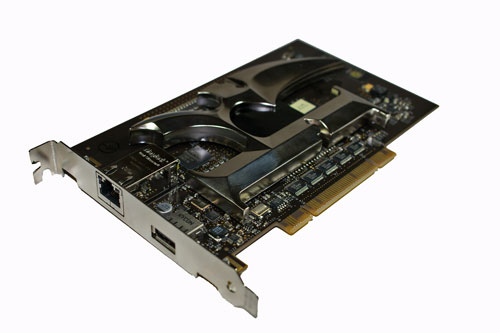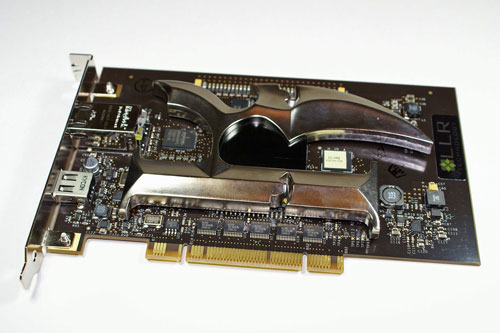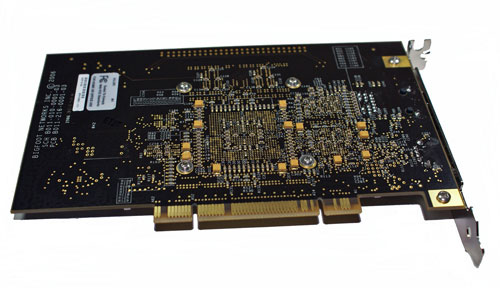BigFoot Networks Killer NIC: Killer Marketing or Killer Product?
by Gary Key on October 31, 2006 2:00 AM EST- Posted in
- Networking
Killer NIC Card
The Killer NIC ships with an installation disc that includes several Linux programs, a few decals, product documentation package, and a full retail copy of F.E.A.R. on DVD.
The Killer NIC is a very interesting card and since the Halloween season is upon us we have to say the thought of removing the "K" heatsink and using it as part of our Blade costume came to mind several different times. The PCB is black in color and contains a significant amount of components that you would never expect to see on a typical NIC. There are also several red LEDs on the PCB whose blinking movements can be adjusted by the control panel. Overall, the card's design theme follows its naming convention.
The card is equipped with a Freescale MPC8347E communications processor, a Xilinx Spartan FPGA, an integrated Broadcom Gigabit PHY, and 64MB of RAM for the embedded Linux build that is accessed by the FNapp Console. The Freescale MPC8347E communications processor is designed for general communications requirements from Ethernet routers to Internet network appliances. The Xilinx Spartan FPGA is a programmable gate array that houses Bigfoot Networks' proprietary and patent pending algorithms that also utilize the 64MB of onboard RAM.

The card utilizes a standard RJ-45 port and includes a USB 2.0 port. The USB 2.0 port is not visible to Windows and is designed to be used by an FNapp. The thought process is that an FNapp can read or write data to a flash drive or external HD. This would be very advantageous for writing data directly to an external hard drive via a BitTorrent type FNapp as one example.
The amount of integrated components along with its basic design features is one of the reasons why this card costs $279.99. This is a price tag that generally puts this card out of reach for most users who are typically satisfied with their NIC's current performance.
The card was very easy to set up. You need to disable your current NIC for optimum performance and compatibility. This is an action that we highly advise after a couple of aborted installs with the original driver set. The card requires a single PCI 2.2 slot and is only compatible with 32-bit Windows XP at this time. After installing the card, a quick reboot, and hardware recognition by XP, you install the driver set off the CD although we highly suggest downloading the latest release first. Another reboot is required and then you are set to use the card for total world domination. Well, at least this is probably your thought process if you read through the marketing material and other documentation online.
Additional 64-bit XP and Linux support is expected within the next six to eight weeks. However, it is still uncertain as to what features will be enabled for Linux and what if any performance benefits will be gained. Windows Vista support should be available by the time the OS ships and it will be interesting to see if there are any improvements considering Microsoft has completely rewritten the network stack code for efficiency and latency reduction. At this point in time there are no plans for a PCI Express version of the Killer NIC. According BigFoot Networks the PCI interface was utilized to improve transactional latencies, programming familiarity, and the fact that most systems have the required amount of PCI slots. We disagree with that last point as the majority of performance oriented boards are now PCI slot starved, and we would expect PCI-E to be a future consideration depending on the success of the current design.
The Killer NIC ships with an installation disc that includes several Linux programs, a few decals, product documentation package, and a full retail copy of F.E.A.R. on DVD.
 |
 |
| Click to enlarge |
The Killer NIC is a very interesting card and since the Halloween season is upon us we have to say the thought of removing the "K" heatsink and using it as part of our Blade costume came to mind several different times. The PCB is black in color and contains a significant amount of components that you would never expect to see on a typical NIC. There are also several red LEDs on the PCB whose blinking movements can be adjusted by the control panel. Overall, the card's design theme follows its naming convention.
The card is equipped with a Freescale MPC8347E communications processor, a Xilinx Spartan FPGA, an integrated Broadcom Gigabit PHY, and 64MB of RAM for the embedded Linux build that is accessed by the FNapp Console. The Freescale MPC8347E communications processor is designed for general communications requirements from Ethernet routers to Internet network appliances. The Xilinx Spartan FPGA is a programmable gate array that houses Bigfoot Networks' proprietary and patent pending algorithms that also utilize the 64MB of onboard RAM.

The card utilizes a standard RJ-45 port and includes a USB 2.0 port. The USB 2.0 port is not visible to Windows and is designed to be used by an FNapp. The thought process is that an FNapp can read or write data to a flash drive or external HD. This would be very advantageous for writing data directly to an external hard drive via a BitTorrent type FNapp as one example.
The amount of integrated components along with its basic design features is one of the reasons why this card costs $279.99. This is a price tag that generally puts this card out of reach for most users who are typically satisfied with their NIC's current performance.
The card was very easy to set up. You need to disable your current NIC for optimum performance and compatibility. This is an action that we highly advise after a couple of aborted installs with the original driver set. The card requires a single PCI 2.2 slot and is only compatible with 32-bit Windows XP at this time. After installing the card, a quick reboot, and hardware recognition by XP, you install the driver set off the CD although we highly suggest downloading the latest release first. Another reboot is required and then you are set to use the card for total world domination. Well, at least this is probably your thought process if you read through the marketing material and other documentation online.
Additional 64-bit XP and Linux support is expected within the next six to eight weeks. However, it is still uncertain as to what features will be enabled for Linux and what if any performance benefits will be gained. Windows Vista support should be available by the time the OS ships and it will be interesting to see if there are any improvements considering Microsoft has completely rewritten the network stack code for efficiency and latency reduction. At this point in time there are no plans for a PCI Express version of the Killer NIC. According BigFoot Networks the PCI interface was utilized to improve transactional latencies, programming familiarity, and the fact that most systems have the required amount of PCI slots. We disagree with that last point as the majority of performance oriented boards are now PCI slot starved, and we would expect PCI-E to be a future consideration depending on the success of the current design.










87 Comments
View All Comments
mlau - Tuesday, October 31, 2006 - link
Correct, I haven't (I do have bills to pay and don't waste what's left on improving my laptop). To me it's absolutely not worth shelling out 500$ so that oblivion runs with 5 fps more. Reducing resolution costs nothing. With the saved money you can buy loads of beers which will make playing that game much more interesting :)The card is too expensive for what it offers, and its benefits will vanish with the
next cpu generation, no doubt. What makes the card interesting is the integrated
offload of all of linux' filtering/routing. The card is marketed to the wrong crowd.
PS: I think ati and nvidia need to be congratulated for finding another
reason for gamers to shell out money. (and look, ati also wants you to buy 3 cards in the
near future, for another completely useless thing: physics "simulation". I bet hundreds
of people can't wait to post benchmarks and how it improved their framerates and how
"physically correct" the dust now settles in $GAME)
rushfan2006 - Wednesday, November 1, 2006 - link
Agreed. I am a gamer a very long time gamer btw...if that counts for anything to do with anything...LOL...I've always built my own gaming boxes throughout the years -- so I think I have some relevant experience to base my opinions on. Though the guy is a bit brutish in how he makes his remarks, factually I believe he's correct in that right now with the state of technology the price:performance ratio for dual cards in games is just not there. If I'm going to invest a total of $1000 (two cards) I'd want to see DRAMATIC improvements. Now we all have our own standards -- so let me define mine...even 10% performance game for that investment is NOT "dramatic" to me. Research the benchmarks from your favorite tech sites, don't take my word for it -- the benchmarks speak for it.As for the topic of this Killer NIC...for me personally, as a gamer, its just a waste of money and the concept of it kind of makes me laugh to be honest.
imaheadcase - Tuesday, October 31, 2006 - link
I agree, crossfire/SLI is not all that at all. Its just a marketing tool to make gamers think they need it. The difference though is that it has some nice uses other than games.Games should be the LAST thing people should think about when getting SLI/Crossfire.
Frumious1 - Tuesday, October 31, 2006 - link
I'm not sure if you're being sarcastic or idiotic. Hopefully the former? Marketing tools are trying to peddle something that has a negligible impact. You know, convincing people to upgrade from a 2.4 GHz E6600 to a 2.93 GHz X6800 for three times the cost... maximum performance increase is 22% for a 200% price hike! CrossFire and SLI on the other hand can give up to a 90% (and usually at least 50%) performance increase for a 100% price increase.Yup, that's totally marketing. So are large LCDs, because those are completely useless. (Yes, that's sarcasm.)
feelingshorter - Tuesday, October 31, 2006 - link
How about spend 300 bucks and buy windows? My bit defender works just fine as a firewall and doesn't use 300 dollars worth of CPU. Hell, you can buy a new cpu and off set any performance hit using software firewall with 300 bucks!Hypernova - Tuesday, October 31, 2006 - link
But as the review says currently there are still NOTHING that shows the potential of FNapps. This is the card 2nd biggest selling point yet there's still nothing to show for it.cosmotic - Tuesday, October 31, 2006 - link
I don't think the "per second" is appropriate.